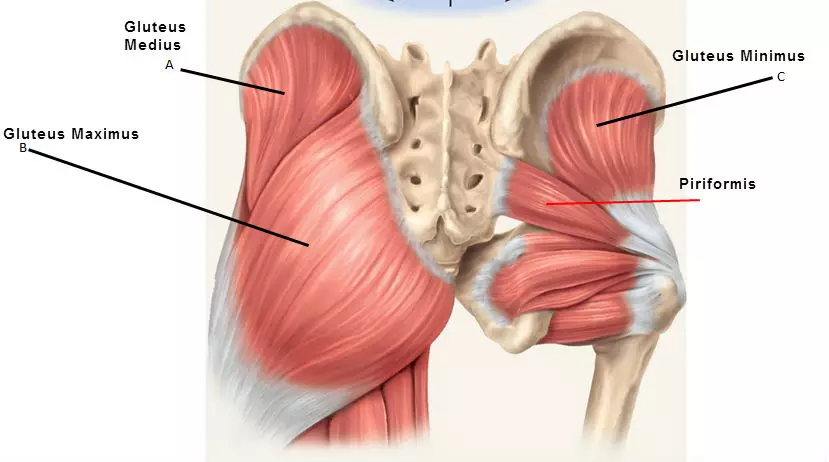Finding Your Glutes
If you’ve been a part of a CrossFit gym for any length of time, you’ve almost definitely heard someone mention glute activation, or how important it is to use your glutes while you’re lifting, squatting, etc. The other end of the spectrum here is that a large percentage of people have no clue what the heck that means or WHY it’s important. Today I wanted to cover some of the reasons why your glutes are important, how to actually be sure you’re using them effectively, and maybe most importantly exactly what people are talking about when they mention glutes.
First of all, what and where the heck are your glutes?
There are actually 3 muscles that make up the glutes. The gluteus maximus, medius, and minimus. These muscles are located along the posterior and lateral (outside) aspect of your hips, and largely work together during functional activity. That said, there are some differences which make it hard to generally say you have glute activation issues or any other broad statement that tends to get thrown around CrossFit gyms. The glute max is the largest muscle group in the body, and is super important for things like walking, squatting, Olympic lifts, and almost everything else that even remotely involves your legs in the gym. It also has a role in rotation of the hip, but more on that later. The glute med and min are a bit more closely related, and play a strong role in abduction (bringing the leg out to the side) and internal/external rotation at the hip joint. From a basic function standpoint, these muscles are massively important to walking effectively. Taking it a step further though, the glutes can really make or break things like your squat and deadlift. The big reason to identify these muscles as individuals vs “the glutes”, besides for the sake of understanding your body, is that you may not have issues with all 3, and that different motions/exercises are needed to bias in the actual muscles you’re trying to train. Now that you have a basic idea of what the glutes are, lets move on to how to know if you’re using them well (or not so well) and how to fix it.

So how do you know what’s working well or not when CrossFit is almost exclusively compound movement training?
Unless you’re a wizard, I really doubt you’re going to be able to feel exactly what’s working at a specific moment during your movement when trying to do complex movements at any form of higher intensity. That doesn’t mean showing a little love to specific muscle groups can’t help you warm-up and get ready to move effectively.
One of the biggest tells for whether you’re firing your glutes effectively can be where you’re getting the most fatigued during a workout/where you’re feeling pain/strain. The two most common places to feel the effects of poor posterior hip (glute) strength/control are the low back and the knee. There is a ton of research out there on both of these topics how hip strengthening/stretching can ease low back and knee pain. The take home is that while low back pain really can’t be generalized to just one magic cause (see more on that here), you can’t go wrong with getting strong. One of my favorite examples of the effects of glute weakness is with low back pain during wall balls. The low back pain I’m mostly referring to is that really tight feeling leading to that fun waddle around the gym afterwards (you know who you are). A lot of that happens when you’re not effectively extending your hips. You could potentially have tight hip flexors contributing to this problem (learn more on that here), but for the sake of today’s argument let’s stick with poor glute strength/control as the big reason. This same problem exists in all types of squatting as well as in running/jumping activities.


Where you see the knee pain come in is often related to the other 2 glute muscles. People tend to be more quad dominant, meaning they use a lot more of the muscles on the front of their thigh to get work done vs using the entire leg. You tend to see a lot of knee caving with these people going along with their knee pain. A nice little test to see how good you are at using the glute med/min and posterior hip in general would be a clamshell. You can check that out through the video here. If you have this type of issue absolutely give a few of the things below a try and watch things like your squat or even your running improve dramatically over time.
A final little test you can do to see whether you’re engaging your glutes during functional movement is the Push Press Test. Zach Long has a good post here about how to perform that test.
You’ve met your glutes! Now what?
Fire up the glutes and get stronger! There’s no magic fix to get any muscle in the body stronger. It’ll take time to truly get additional strength in any muscle group. The good news is that if you have issues firing the muscles or moving effectively, you’ll see some pretty cool changes in your lifts and movement with some consistent work over a few weeks just from your body learning how to move better. Below I’ve listed a few exercises you can try to warm-up and start firing your glutes. These can also be great accessory movements to throw into your gym routine if you increase the reps and difficulty (bands, weight, holds, etc.). Give them a try and let me know what you think!
Clamshells –
Glute Bridges –
Single Leg Variation (from The Barbell Physio) –
Fire Hydrants –
Plank with Hip Internal Rotation –
Hip Thrusts –
As always guys, the tips and exercises I went over above are just that – tips. If you truly have an injury, or have pain with anything above or during your workouts, there’s no substitute for an expert exam from a qualified medical professional. If you have questions about anything related to your movement or any pain you may be having, absolutely reach out and I’ll do my best to provide some insight and guide you on your best next step. The whole point of exercise (besides donuts) is to be able to move well longer. Be smart with your body and take care of it.
Feel free to reach out through dan@breakthroughperformanceavl.com with questions, or DM us on our Facebook Page!



